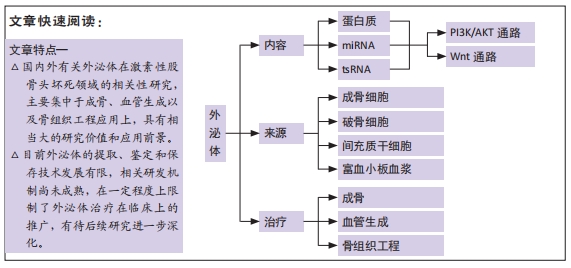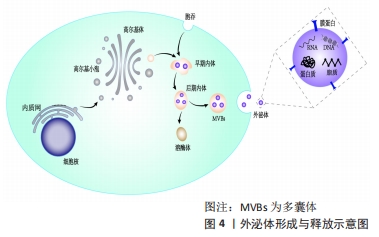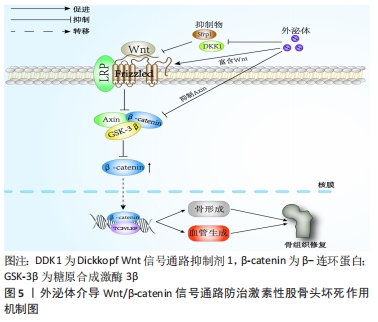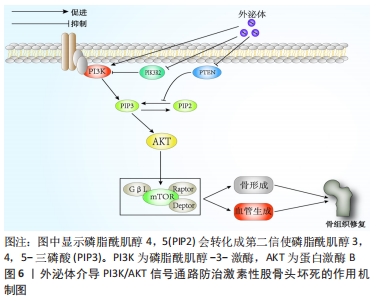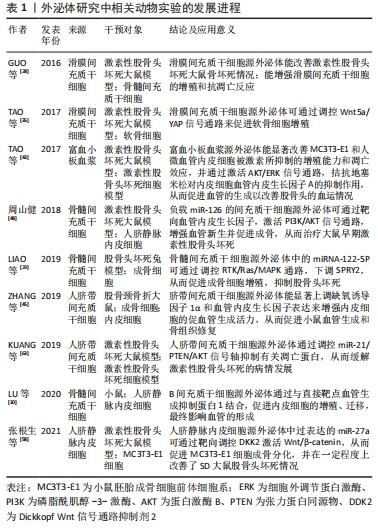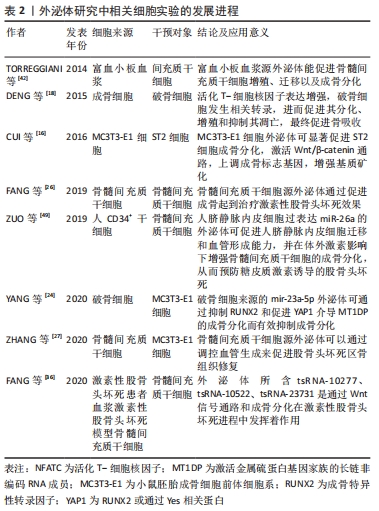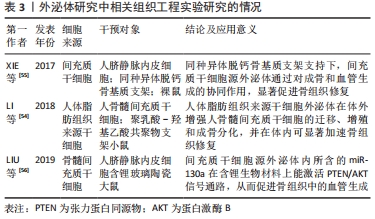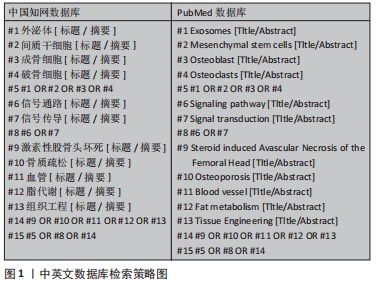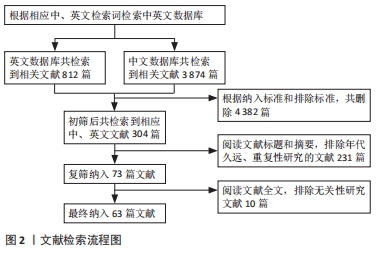[1] 曾宪峰,王进东,梁鼎天,等.补肾活血汤联合西医治疗早中期非创伤性股骨头缺血坏死(肾虚血瘀)随机平行对照研究[J].实用中医内科杂志,2019,33(5):38-41.
[2] RECORD M, SUBRA C, SILVENTE P, et al. Exosomes as intercellular signalosomes and pharmacological effectors. Biochem Pharmacol. 2011; 81(10):1171-1182.
[3] PISHAVAR E, LUO H, NASERIFAR M, et al. Advanced hydrogels as exosome delivery systems for osteogenic differentiation of mscs: application in bone regeneration. Int J Mol Sci. 2021;22(12):6203.
[4] 贾亚超.外泌体及纳米微粒促进牵张成骨骨再生的研究[D].上海:上海交通大学,2019.
[5] 魏松乔,郭澍,佟爽,等.脂肪干细胞-丝素/壳聚糖支架复合物在外泌体诱导下的体外成骨效应[J].中国医科大学学报,2019,48(10):891-895.
[6] 陈义庆,郭澍,佟爽,等.可注射水凝胶负载脂肪来源干细胞外泌体促进骨再生[J].中国美容整形外科杂志,2019,30(4):206-209.
[7] ZHANG Y, LIU YF, LIU HY, et al. Exosomes: biogenesis, biologic function and clinical potential. Cell Biosci. 2019;9:19.
[8] MARIA FB, ZHE Z, EVA M, et al. Syndecan-syntenin-ALIX regulates the biogenesis of exosomes. Nat Cell Biol. 2012;14(7):677-685.
[9] PEREZ-HERNANDEZ D, GUTIÉRREZ-VÁZQUEZ C, JORGE I, et al. The intracellular interactome of tetraspanin-enriched microdomains reveals their function as sorting machineries toward exosomes. J Biol Chem. 2013; 288(17):11649-11661.
[10] ROUCOURT B, MEEUSSEN S, BAO J, et al. Heparanase activates the syndecan-syntenin-ALIX exosome pathway. Cell Res. 2015;25(4):412-428.
[11] OSTROWSKI M, CARMO NB, KRUMEICH S, et al. Rab27a and Rab27b control different steps of the exosome secretion pathway. Nat Cell Biol. 2010;12(1): 19-30.
[12] TUCKER WC, CHAPMAN ER. Role of synaptotagmin in Ca2+-triggered exocytosis. Biochem J. 2002;366(Pt 1):1-13.
[13] MIN G, WU YZ, KE RH, et al. Value of osteoblast-derived exosomes in bone diseases. J Craniofac Surg. 2017;28(4):866-870.
[14] MIN G, KE RH, CAI TY, et al. Identification and proteomic analysis of osteoblast-derived exosomes. Biochem Biophys Res Commun. 2015;467(1): 27-32.
[15] YOSHIHIRO N, SHIGERU M, HIROYUKI I, et al. Mesenchymal-stem-cell-derived exosomes accelerate skeletal muscle regeneration. FEBS Lett. 2015; 589(11):1257-1265.
[16] CUI YZ, LUAN J, LI HY, et al. Exosomes derived from mineralizing osteoblasts promote ST2 cell osteogenic differentiation by alteration of microRNA expression. FEBS Lett. 2016;590(1):185-192.
[17] BIRMINGHAM E, NIEBUR GL, MCHUGH PE, et al. Osteogenic differentiation of mesenchymal stem cells is regulated by osteocyte and osteoblast cells in a simplified bone niche. Eur Cell Mater. 2012;23:13-27.
[18] DENG L, WANG Y, PENG Y, et al. Osteoblast-derived microvesicles: a novel mechanism for communication between osteoblasts and osteoclasts. Bone. 2015;79:37-42.
[19] TAVEMA S, PUCCI M, GIALLOMBADO M, et al. Amphiregulin contained in NSCLC-exosomes induces osteoclast differentiation through the activation of EGFR pathway. Sci Rep. 2017;7(1):3170.
[20] HUYNH N, VONMOSS L, SMITH D, et al. Characterization of regulatory extracellular vesicles from osteoclasts. J Dent Res. 2016;95(6):673-679.
[21] SUN WJ, ZHAO CY, Li YH, et al. Osteoclast-derived microRNA-containing exosomes selectively inhibit osteoblast activity. Cell Discov. 2016;2:16015.
[22] WANG XG, GUO BS, QI L, et al. miR-214 targets ATF4 to inhibit bone formation. Nat Med. 2013;19(1):93-100.
[23] ZHAO C, SUN W, ZHANG P, et al. miR-214 promotes osteoclastogenesis by targeting Pten/PI3k/Akt pathway. RNA Biol. 2015;12(3):343-353.
[24] YANG JX, XIE P, LI YS, et al. Osteoclast-derived miR-23a-5p-containing exosomes inhibit osteogenic differentiation by regulating Runx2. Cell Signal. 2020;70:109504.
[25] XQ WANG, OMAR O, FORUGH V, et al. Mesenchymal stem cell-derived exosomes have altered microRNA profiles and induce osteogenic differentiation depending on the stage of differentiation. PLoS One. 2018; 13(2):e0193059.
[26] FANG SH, LI YF, CHEN P. Osteogenic effect of bone marrow mesenchymal stem cell-derived exosomes on steroid-induced osteonecrosis of the femoral head. Drug Des Devel Ther. 2018;13:45-55.
[27] ZHANG C, SU Y, DING H, et al. Mesenchymal stem cells-derived and siRNAs-encapsulated exosomes inhibit osteonecrosis of the femoral head. J Cell Mol Med. 2020;24(17):9605-9612.
[28] GUO SC, TAO SC, YIN WJ, et al. Exosomes from human synovial-derived mesenchymal stem cells prevent glucocorticoid-induced osteonecrosis of the femoral head in the rat. Int J Biol Sci. 2016;12(10):1262-1272.
[29] LIAO W, NING Y, XU HJ, et al. BMSC-derived exosomes carrying microRNA-122-5p promote proliferation of osteoblasts in osteonecrosis of the femoral head. Clin Sci (Lond). 2019;133(18):1955-1975.
[30] LU GD, CHENG P, LIU T, et al. BMSC-derived exosomal miR-29a promotes angiogenesis and osteogenesis. Front Cell Dev Biol. 2020;8:608521.
[31] WU RW, LIAN WS, CHEN YS, et al. MicroRNA-29a counteracts glucocorticoid induction of bone loss through repressing TNFSF13b modulation of osteoclastogenesis. Int J Mol Sci. 2019;20(20):5141.
[32] LIAN WS, KO JY, CHEN YS, et al. MicroRNA-29a represses osteoclast formation and protects against osteoporosis by regulating PCAF-mediated RANKL and CXCL12. Cell Death Dis. 2019;10(10):705.
[33] XU JF, YANG GH, PAN XH, et al. Altered microRNA expression profile in exosomes during osteogenic differentiation of human bone marrow-derived mesenchymal stem cells. PLoS One. 2014;9(12):e114627.
[34] 郭尚春.外泌体对组织修复的作用及其机制研究[D].上海:上海交通大学,2016.
[35] TAO SC, YUAN T, ZHANG YL, et al. Exosomes derived from miR-140-5p-overexpressing human synovial mesenchymal stem cells enhance cartilage tissue regeneration and prevent osteoarthritis of the knee in a rat model. Theranostics. 2017;7(1):180-195.
[36] FANG SH, HE TM, JIANG J, et al. Osteogenic effect of tsRNA-10277-loaded exosome derived from bone mesenchymal stem cells on steroid-induced osteonecrosis of the femoral head. Drug Des Devel Ther. 2020;14: 4579-4591.
[37] ZHANG YF, XU JK, YE CR, et al. Implant-derived magnesium induces local neuronal production of CGRP to improve bone-fracture healing in rats. Nat Med. 2016;22(10):1160-1169.
[38] YOSHIDA H, HAYASHI SI, KUNISADA T. The murine mutation osteopetrosis is in the coding region of the macrophage colony stimulating factor gene. Nature. 1990;345(6274):442–444.
[39] GHOSH CN, SINGHA PK, WOODRUFF K, et al. Concerted action of Smad and CREB-binding protein regulates bone morphogenetic protein-2-stimulated osteoblastic colony-stimulating factor-1 expression. J Biol Chem. 2006;281(29):20160-20170.
[40] GABRIELA F, YANG SY. Application of platelet-rich plasma with stem cells in bone and periodontal tissue engineering. Bone Res. 2016;4:16036.
[41] TONG SC, YIN JM, LIU J. Platelet-rich plasma has beneficial effects in mice with osteonecrosis of the femoral head by promoting angiogenesis. Exp Ther Med. 2018;15(2):1781-1788.
[42] TORREGGIANI E, PERUT F, RONCUZZI L, et al. Exosomes: novel effectors of human platelet lysate activity. Eur Cell Mater. 2014;28:137-151.
[43] TAO SC, YUAN T, RUI BY, et al. Exosomes derived from human platelet-rich plasma prevent apoptosis induced by glucocorticoid-associated endoplasmic reticulum stress in rat osteonecrosis of the femoral head via the Akt/Bad/Bcl-2 signal pathway. Theranostics. 2017;7(3):733-750.
[44] QI X, ZHANG JY, YUAN H, et al. Exosomes secreted by human-induced pluripotent stem cell-derived mesenchymal stem cells repair critical-sized bone defects through enhanced angiogenesis and osteogenesis in osteoporotic rats. Int J Biol Sci. 2016;12(7):836-849.
[45] ZHANG YT, HAO ZC, WANG PF, et al. Exosomes from human umbilical cord mesenchymal stem cells enhance fracture healing through HIF-1α-mediated promotion of angiogenesis in a rat model of stabilized fracture. Cell Prolif. 2019;52(2):e12570.
[46] TENG XM, CHEN L, CHEN WQ, et al. Mesenchymal stem cell-derived exosomes improve the microenvironment of infarcted myocardium contributing to angiogenesis and anti-inflammation. Cell Physiol Biochem. 2015;37(6):2415-2424.
[47] ZHANG L, OUYANG PR, HE GL, et al. Exosomes from microRNA-126 overexpressing mesenchymal stem cells promote angiogenesis by targeting the PIK3R2-mediated PI3K/Akt signalling pathway. J Cell Mol Med. 2021; 25(4):2148-2162.
[48] 周山健.负载miR-126的外泌体对大鼠早期激素诱导的缺血性股骨头坏死的治疗作用[D].锦州:锦州医科大学,2018.
[49] ZUO RT, KONG LC, WANG MW, et al. Exosomes derived from human CD34+ stem cells transfected with miR-26a prevent glucocorticoid-induced osteonecrosis of the femoral head by promoting angiogenesis and osteogenesis. Stem Cell Res Ther. 2019;10(1):321.
[50] FLEURY A, MARTINEZ MC, LE LS. Extracellular vesicles as therapeutic tools in cardiovascular diseases. Front Immunol. 2014;5:370.
[51] ZHANG SP, KRISTEEN YWT, SHANG JC, et al. MSC exosomes alleviate temporomandibular joint osteoarthritis by attenuating inflammation and restoring matrix homeostasis. Biomaterials. 2019;200:35-47.
[52] YUAN X, Chen L, YAN CC, et al. Circulating exosomal mir-20b-5p inhibition restores wnt9b signaling and reverses diabetes-associated impaired wound healing. Small. 2020;16(3):e1904044.
[53] WATARU K, MASASHI O, TAKAMASA K, et al. First-in-human study and clinical case reports of the alveolar bone regeneration with the secretome from human mesenchymal stem cells. Head Face Med. 2016;12:5.
[54] LI WY, LIU YS, ZHANG P, et al. Tissue-engineered bone immobilized with human adipose stem cells-derived exosomes promotes bone regeneration. ACS Appl Mater Interfaces. 2018;10(6):5240-5254.
[55] XIE H, WANG ZX, ZHANG LM, et al. Extracellular vesicle-functionalized decalcified bone matrix scaffolds with enhanced pro-angiogenic and pro-bone regeneration activities. Sci Rep. 2017;7:45622.
[56] LIU L, LIU YQ, FENG C, et al. Lithium-containing biomaterials stimulate bone marrow stromal cell-derived exosomal miR-130a secretion to promote angiogenesis. Biomaterials. 2019;192:523-536.
[57] YAO Z, LIN TY, LI YW, et al. Exosome-mimetics as an engineered gene-activated matrix induces in-situ vascularized osteogenesis. Biomaterials. 2020;247:119985.
[58] 张根生,刘瑞宇,党晓谦,等.miR-27a过表达的血管内皮细胞来源外泌体改善股骨头坏死实验研究[J].中国修复重建外科杂志,2021,35(3): 356-365.
[59] 宋世雷,陈跃平,章晓云.PI3K/AKT信号通路调控股骨头坏死的相关机制[J].中国组织工程研究,2020,24(3):408-415.
[60] SESSA R, SEANO G, DI BL, et al. The miR-126 regulates angiopoietin-1 signaling and vessel maturation by targeting p85β. Biochim Biophys Acta. 2012;1823(10):1925-1935.
[61] WALTERS N, NGUYEN LTH, ZHANG JJ, et al. Extracellular vesicles as mediators of in vitro neutrophil swarming on a large-scale microparticle array. Lab Chip. 2019;19(17):2874-2884.
[62] XUE XH, FENG ZH, LIi ZX, et al. Salidroside inhibits steroid-induced avascular necrosis of the femoral head via the PI3K/Akt signaling pathway: In vitro and in vivo studies. Mol Med Rep. 2018;17(3):3751-3757.
[63] KUANG MJ, HUANG Y, ZHAO XG, et al. Exosomes derived from Wharton’s jelly of human umbilical cord mesenchymal stem cells reduce osteocyte apoptosis in glucocorticoid-induced osteonecrosis of the femoral head in rats via the miR-21-PTEN-AKT signalling pathway. Int J Biol Sci. 2019;15(9): 1861-1871.
|
